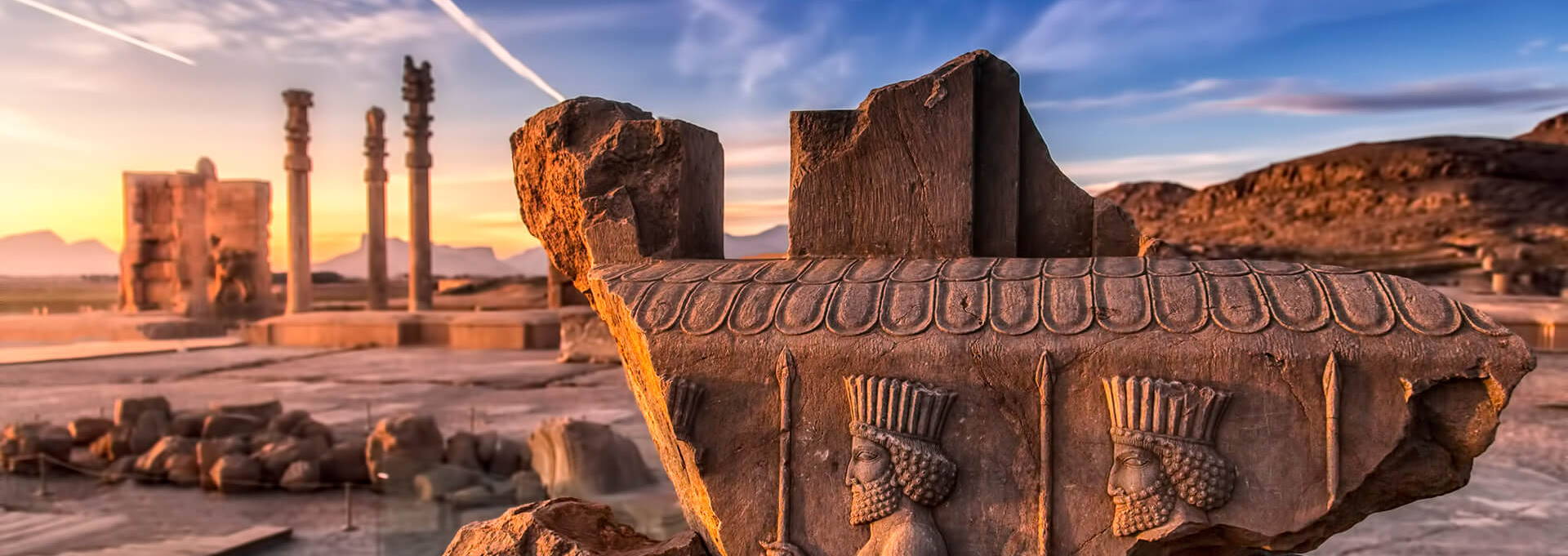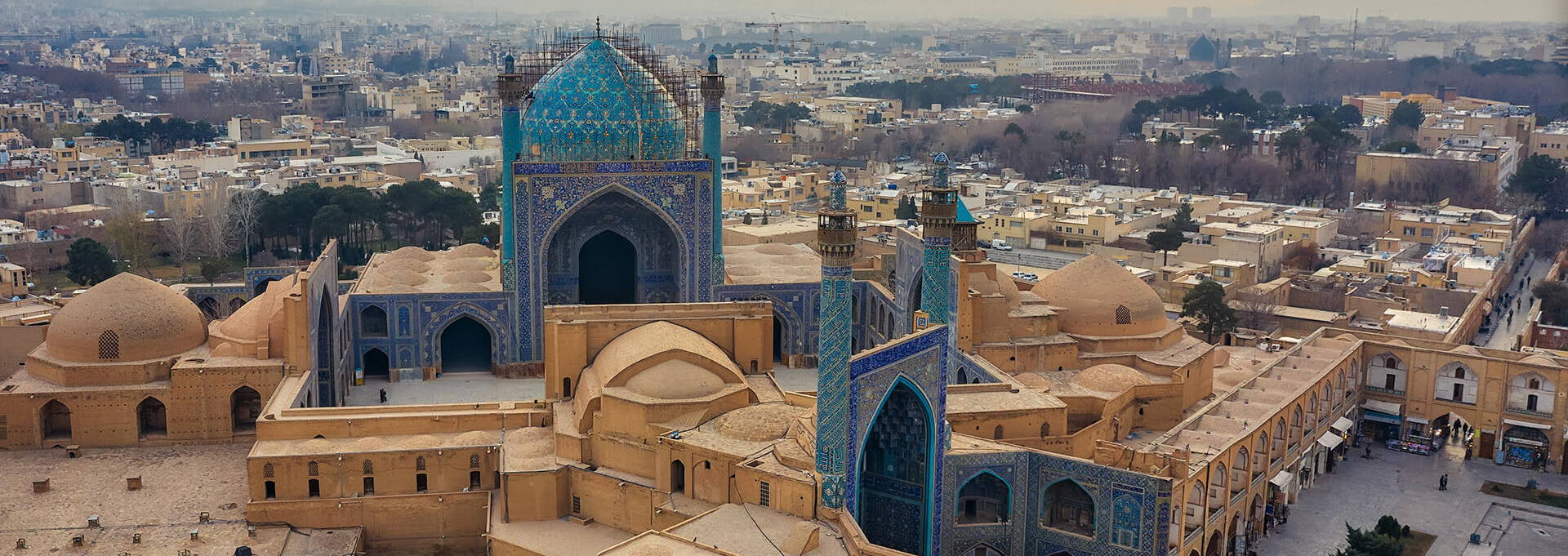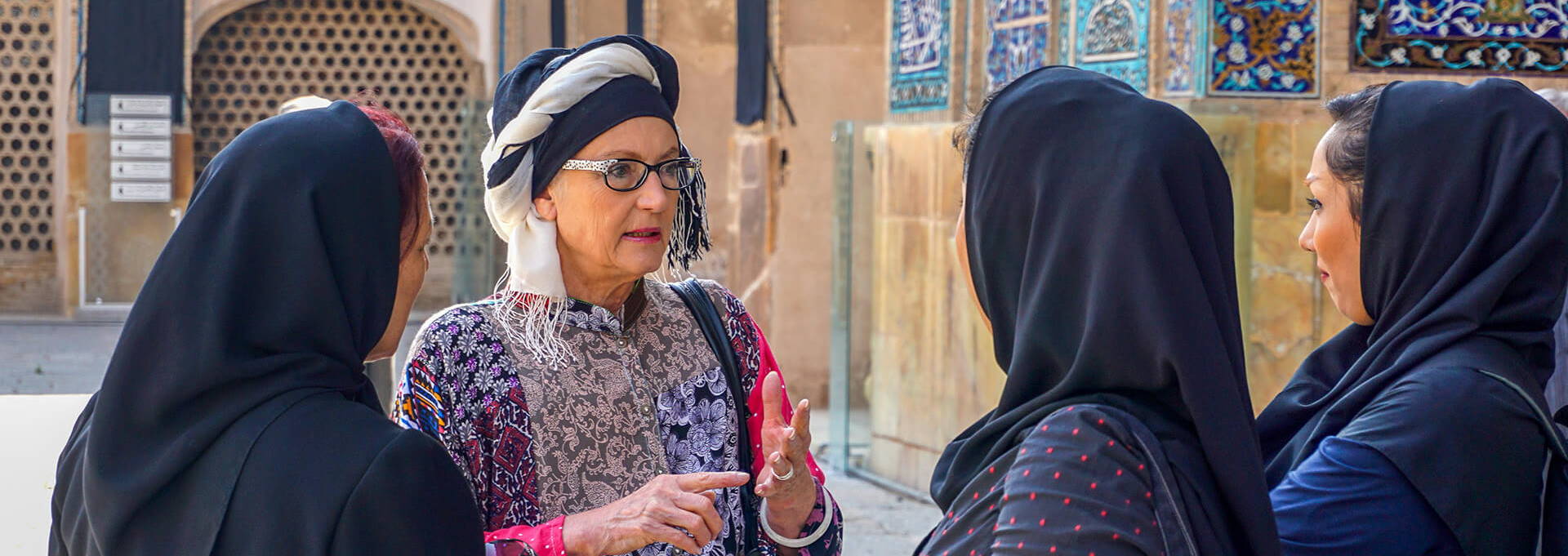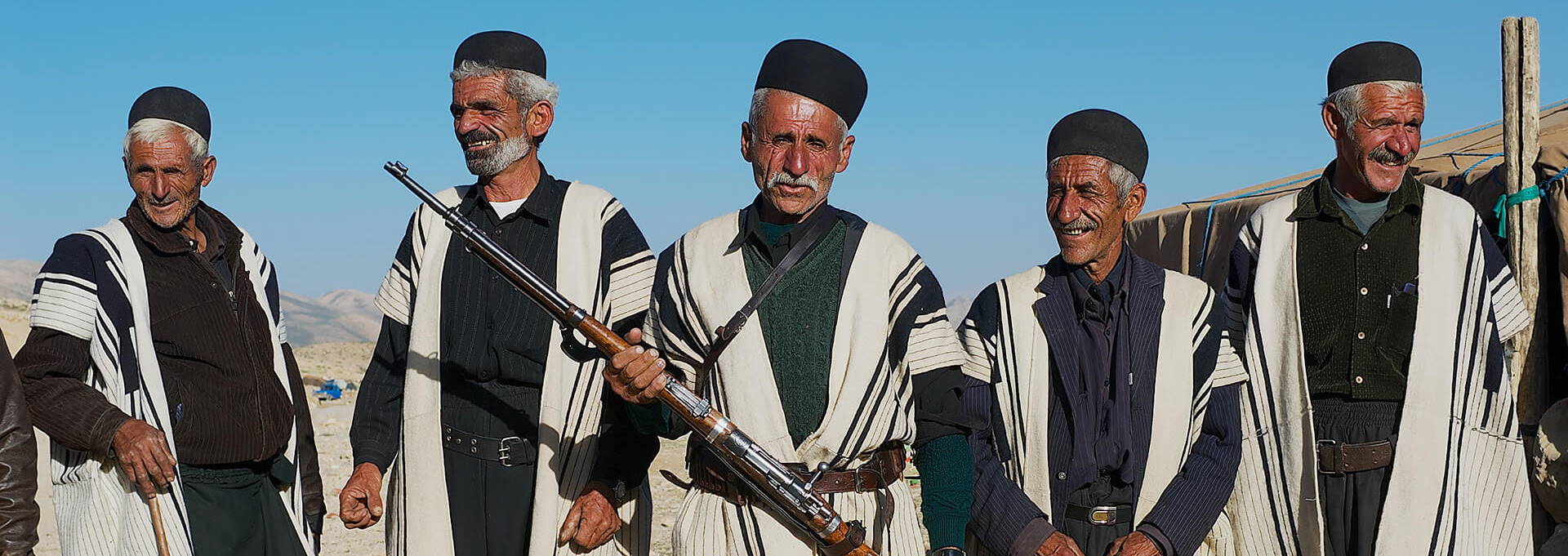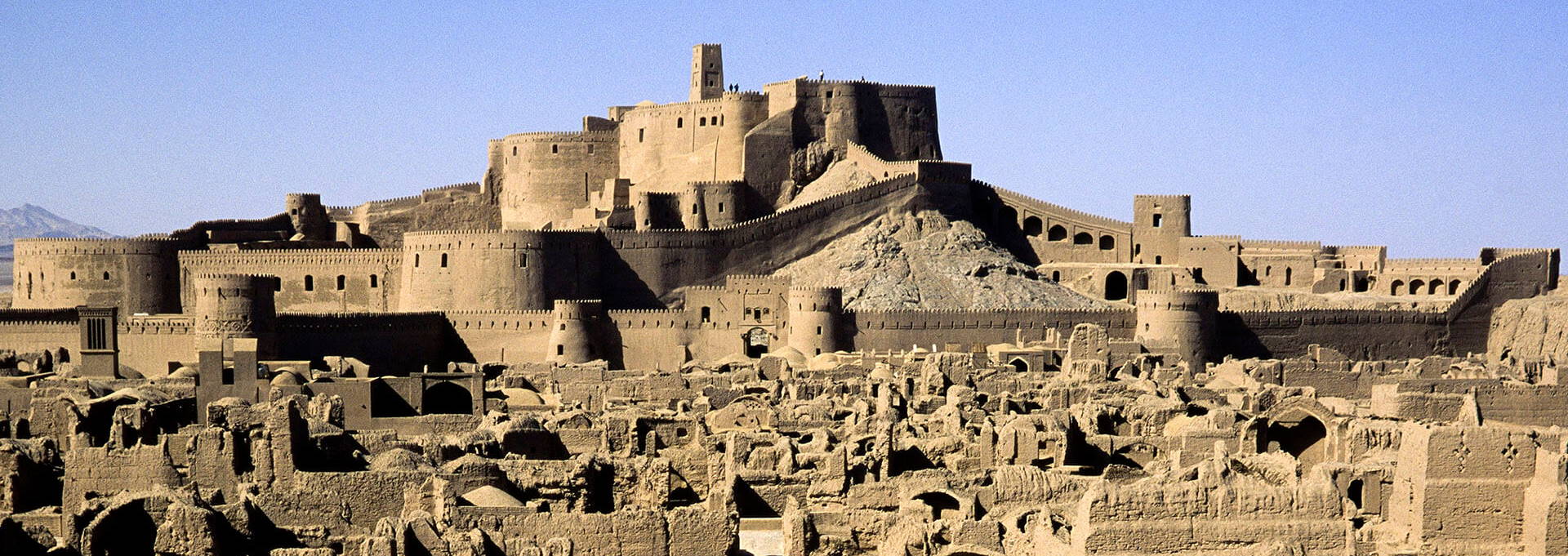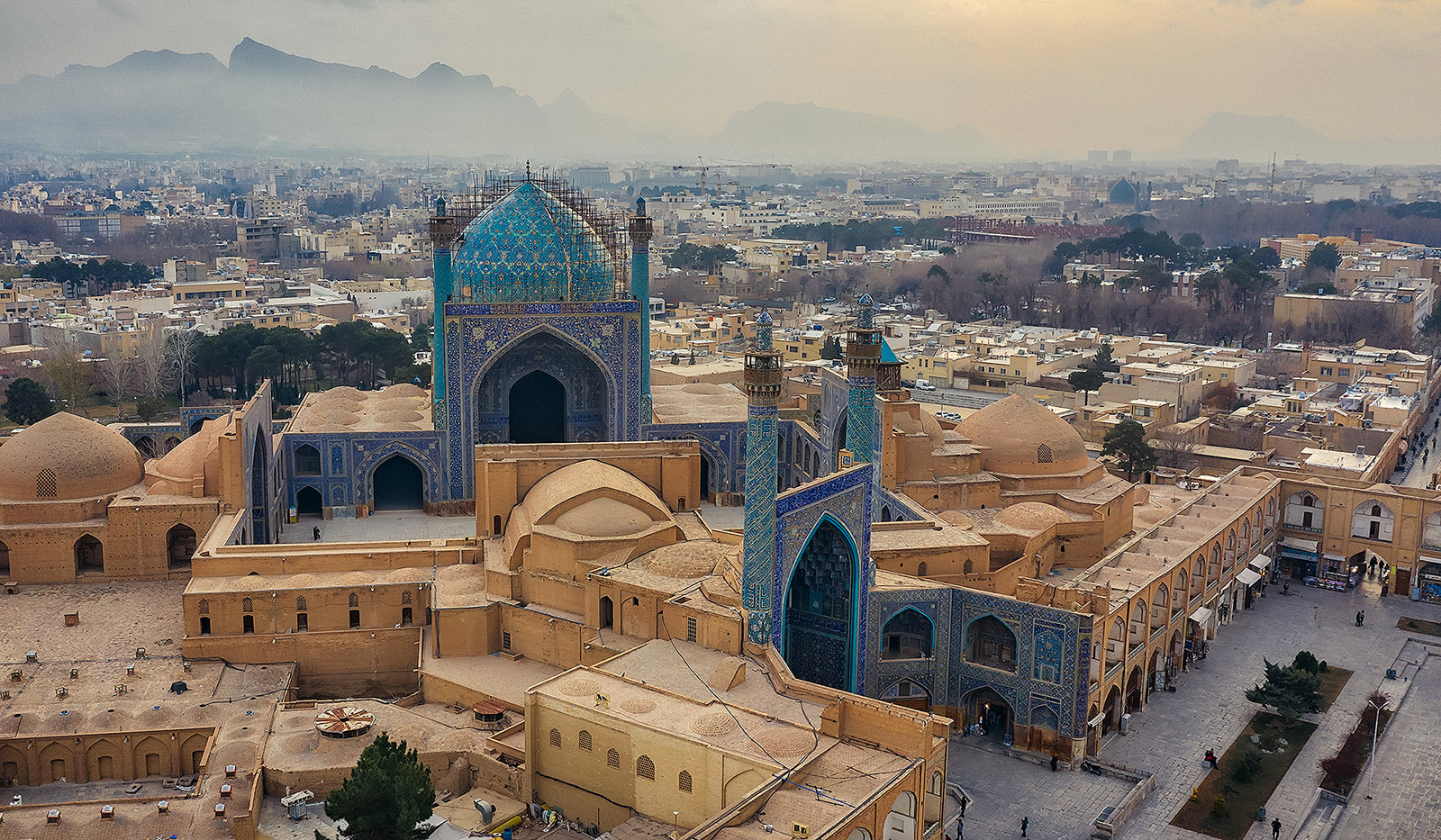THE STORY
Alexander the Great was a legendary warrior and conqueror, widely considered one of the greatest military minds the world has ever seen. By the time he was just 30 years of age, he had created one of the ancient world’s largest empires, stretching from Greece to India.
This one-of-a-kind expedition explores the incredible story of Alexander the Great’s conquest of Persia and the destruction of the Achaemenid Empire. Taking in the iconic highlights of Iran, our journey first investigates the rise the Achaemenids and their warrior kings Cyrus, Darius and Xerxes – conquerors of much of the ancient world. We then meet Alexander’s army, as they cross from what is today Iraq, to take the ancient city of Susa, and follow in their footsteps through the decisive battle of the Persian Gates and the sacking of the Royal complex at Persepolis.
During our travels, we explore the great cities Alexander spared and those he destroyed, the sites of battle, as well as the great twists and turns of his headlong pursuit of Darius III. In the deserts of southern Iran, we pickup Alexander and his army as they return from India and search for one of Alexander’s legendary lost cities – Alexandria in Carmania. Along the way we have the thrilling experience of exploring two of the largest circularcities of the ancient world – Gour and Darabgerd.
Throughout this expedition, we are joined by leading Iranian archaeologists and academics, who give us exclusive access to their digsites and rare insight into this fascinating history. Staying in the finest hotels Iran has to offer, the tour culminates with three nights each in Shiraz and Isfahan for our guests to immerse themselves in the bazaars, food, street life and extraordinary architecture of these fabled cities.
![]()
EXPEDITION LEADER DR JOHN TIDMARSH

John is an accomplished archaeologist who has conducted excavations in Syria, Jordan, Greece, and Cyprus. He is currently Co-Director of the University of Sydney excavations at Pella in Jordan. He is also Co-Director of the Australian Mission to Jebel Khalid (Syria), a remarkable purely Hellenistic site founded by Alexander the Great or his general Seleucus. He was previously Senior Investigator of the University of Sydney excavations in Torone, Greece and Associate Director of the University of Sydney excavations at Paphos, Cyprus. His main interests are in the art, archaeology and history of Alexander the Greatand the Hellenistic period in the East, and in the Islamic World.
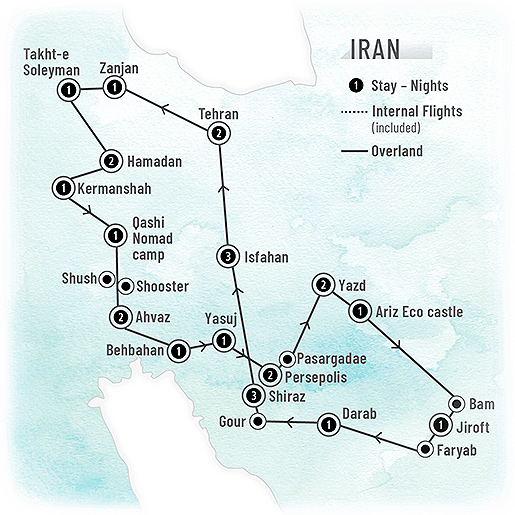
ITINERARY
DAY 01 – ARRIVE TEHRAN
On arrival at Tehran International Airport, you will be met at the arrivals gate by an Arcadia representative and transferred by private vehicle to your hotel.
At 6pm you shall be met by your Expedition Leader before dining together at one of the city’s best traditional restaurants for our welcome dinner and expedition briefing.
Firouz Boutique Hotel, Tehran | D
DAY 02 – TEHRAN
After breakfast, we begin the fascinating story of the Achaemenids and Alexander’s destruction of their empire. The prologue to our story unfolds just on the outskirts of Tehran in the ancient capital of Rhagae. In the summer heat of July 330 BCE, Darius lll, King of the Achaemenid Empire, flees the city with a small retinue. Just a day or so behind him comes his great nemes is Alexander the Great who, having defeated the Persian army at the Battle of the Persian Gates, now closes in on the great King.
ARCADIA EXCLUSIVE
We meet the curator of Tehran’s Reza Abbasi Museum this morning, who will show us around the museum and give us a unique insight into the history and culture of the Achaemenids
In the late morning we move to the Archaeological Museum where our Expedition Leader will guide us through the exhibits that illustrate our story. We then enjoy lunch at the Museum’s restaurant, before walking off our meal with a stroll through City Park to the grand bazaar – the heart of Tehran’s community and economy since the 19th century, where we tap into the life of this bustling city
In the afternoon we drive up into the mountains to the historic Village of Darband, with its breath-taking views over Tehran, and have an early dinner atone of the famous kebab houses overlooking the city.
Firouz Boutique Hotel, Tehran | B,L,D
DAY 03 – ZANJAN
After breakfast, we begin our journey back in time to the genesis of the Achaemenid Empire at the extraordinary site of Takhti-e-Soleyman – The Throne of Solomon. To reach this remote and enigmatic place, we head west via Qazvin where we stop for lunch in the Madan just outside the spectacular Imamzedeh Hossein Tomb before driving on to Zanjan, where we explore the magnificent Mausoleum of Uljaitu. Its huge 51 metre dome, one of the largest in the world, is celebrated for its spectacular stucco and tile work.
We then check into our hotel and dine at a restaurant in the centre of Zanjan.
Dadamaan Hotel, Zanjan | B,L,D
DAY 04 – TAKHT-E SOLEYMAN
After breakfast, we drive westward to Takhti-e- Soleyman (The Throne of Solomon). This incredible World Heritage listed site received its biblical name after the Arab Invasion of Iran in the 7th century. Human settlements have existed in the immediate region since at least the 1st millennium BCE, withthe earliest remains built around the ‘bottomless lake’ from the Achaemenian culture (559-330 BCE). During this period the fire temple of Adur Gushasp was
first constructed and became one of the greatest religious sanctuaries of Zoroastrianism, functioning through three dynasties (Achaemenian, Parthian and Sassanian) for nearly a thousand years.
Peri Eco Lodge – Baba Nazar, Takht-e Soleyman | B,L,D
DAY 05 – HAMADAN
After breakfast, we drive to Hamadan. We have lunch at a restaurant inthe central Medan, which is closed to traffic, and then stroll through Tepe Hegmataned, thought to be ancient Ecbatana.
Here we cross the path of Alexander as he leaves his armies behind and races after Darius III in the final days of his life. We see the stone lion said to have been commissioned by Alexander to commemorate the death of his companion Hephaestion. It is here in Ecbatana that Alexander also orders the death of his father’s trusted General Parmenion because of the actions of his treasonous son.
Amiran 2 Hotel, Hamadan | B,L,D
DAY 06 – HAMADAN
This morning we head south to explore one of the earliest and best-preserved fire temples in western Iran – the ancient Iron Age settlement known as TepeNush-e Jan.
“It is often described as a Median site, however, there is a problem, according to written sources, the Medes were masters of large parts of Iran and Turkey, so we would expect to find more or less the same objects in the centres of government. However, so far, it has been impossible to identify the objects that represent the Median state. The empire of the Medes is not an archaeological fact (yet), but exists only as something mentioned by Herodotus and texts based (directly or indirectly) upon this entertaining Greek author, like the Biblical book of Daniel. A possible explanation for this discrepancy is that the Medians remained nomadic, and that Herodotus has projected aspects of the Achaemenids – a real, fully developed state – backwards.” – Livius.org
We return to Hamedan for lunch before exploring the Mausoleum of Esther &Mordechai in the heart of Hamadan. According to Herodotus, Ecbatana was chosen as the Medes’ capital in the late 8th century BCE by Deioces and became the summer residence of the Achaemenid Kings. We visit the Ganjnameh, two cuneiform inscriptions by Darius the Great (522-486 BCE) and his son Xerxes (486-465 BCE), carved into the rocks of the main east-west pass through Mt.Alavand for all to see.
Darius’s inscription reads – “A great god is Ahuramazda, who created this earth,who created yonder heaven, who created men, who created happiness for man,who made Darius king. One king for many, one lord for all. I am Darius, the great king, king of kings, king of countries containing all kinds of men, king in this great earth far and wide, son of Hystaspes, an Achaemenian.
Amiran 2 Hotel, Hamadan | B,L,D
DAY 07 – KERMANSHAH
We leave Hamadan and continue along the Persian Royal Road, linking the Iranian High Plateau with Mesopotamia, to Kangavar, to explore the evocative Temple of Anahita – the Goddess of Water and Fertility. The complex is enigmatic, displaying Persian Architectural design but Hellenistic in character. We then drive to our atmospheric accommodation for the night, the Bisotun Laleh Hotel, a converted Safavid Caravansari, to check in and have lunch.
This afternoon, we explore the remarkable sites around the Bisotun historical complex on foot, including the vast bas-relief and cuneiform inscription ordered by Darius the Great when he rose to the throne of the Persian Empirein 521 BCE. It portrays Darius treading on the chest of Gaumata, the Median Magus and pretender to the throne, whose assassination led to Darius’s rise to power. The 1,200 lines of inscriptions (in Elamite, Babylonian and Old Persian) tell the story of the battles waged by Darius from 521-520 BCE against the governors who attempted to take apart the Empire founded by Cyrus. Translated by the extraordinary Henry Rawlinson (a story in itself), it is the only known monumental text of the Achaemenids to document the re-establishment of the Empire by Darius I.
The inscription is to cuneiform what the Rosetta Stone is to Egyptian hieroglyphs: the document most crucial in the decipherment of a previously lostscript. There are also the remains of an incomplete Sassanid palace and the Hunters Cave that dates from the Middle paleolithic.
Bistoon Laleh Hotel, Kermanshah | B,L,D
DAY 08 – QASHQAI NOMAD CAMP - ZAGROS MOUNTAINS
After breakfast, we drive to Taq e Bostan in Kermanshah and have morning teaby the lake before exploring this wondrous site. We then head into the Zagros Mountains to our Nomadic Camp, where we experience life as a nomad with the Qashqai people. With their extraordinary hospitality, we gain a unique insight into their way of life and have a glimpse as to what is must have been like for Alexander’s army in camp.
NB: Staying with the Nomads is contingent on their movements, alternatively we will drive directly to Ahvaz and base ourselves there to explore Susa and Shooster.
Qashqai Nomad Camp – Zagros Mountains (or Pars Hotel, Ahvaz) | B,L,D
DAY 09 – SUSA & SHOOSTER
After a traditional breakfast with the nomads, we drive from our camp to Susa (Shush) and visit the site of the Achaemenid Apadana Palace, Susa Museum and Danial Nabi Tomb (Prophet Daniel).
We then move on to Tchogha Zanbil Ziggurat (c.1250 BCE). The zigguratis arguably the most distinct architectural feature of the Mesopotamian civilization. Nevertheless, some of these structures have been found to exist outside the area once occupied by the Mesopotamian’s. Because of its placement on the road between Susa and Persis, this landmark would have been familiar to many travellers—including the likes of Cyrus and Alexander the Great. We then drive to Ahvaz to overnight.
Pars Hotel, Ahvaz | B,L,D
DAY 10 – BEHBAHAN
We drive to Shushtar for lunch and then explore the ancient hydraulic system that includes water mills, dams, tunnels, and canals. Its construction canbe traced back to Darius the Great in the 5th century B.C. This island city was registered on UNESCO’s list of World Heritage Sites in 2009. The ancient Royal Road between Susa, the capital of Elam, and Persepolis, the capital of Achaemenid Persia, crosses the large river modern Karun at Shushtar. From the Persepolis fortification tablets, we know that the old Elamite name of Shushtar was Šurkutir – Alexander crosses the river on this site in the last month of 331 BCE.
After lunch we drive to Behbahan
Mohseni Ecolodge | B,L,D
DAY 11 – YASUJ
After breakfast we drive to Yasuj. We have arranged to stay with a family who live near the important battle ground of the Persian Gates, where Alexander defeats the Persian army. We head up to the pass to explore the battleground with the family as our guides. They relate the story of Aryobarzanes the Brave, an Achaemenid prince, satrap and military commander, who led a last standagainst Alexander. After a picnic lunch with local foods, we take up the different positions of the two armies and learn of this famed battle on the ground where it all unfolded. We then stay overnight with the family
Yasui family homestay | B,L,D
DAY 12 – PERSEPOLIS
After breakfast, we drive eastwards through the Persian Gates (the pass of Cheshme Chenar) and follow Alexander’s line of march through the villages of Tang-e Boraq and Mehenjan, where we stop for a picnic lunch at the waterfall of ‘The Lost Paradise’.
Our first glimpse of Persepolis is the same as Alexander as we arrive at the city site with plenty of time for our first visit through the afternoon. We walk in Alexander’s footsteps and the events leading up to the burning of the palace andits fallout and the changes that effect Alexander thereafter. As our hotel is only metres from the entrance to this incredible World Heritage site, we can remainin the ruins for the sunset before checking in to our hotel.
Apadana hotel, Persepolis | B,L,D
DAY 13 – PERSEPOLIS
In the morning, its up early for a pre-breakfast exploration of Persepolis, allowing those keen on photography to capture both sunset and sunrise across the palace complex before the bulk of tourists arrive from Shiraz. After a leisurely breakfast we then drive over to the Royal Nec ropolis of Naghsh-eRustam. A World Heritage Site, it is the final resting place of the four Achaemenid Kings – Darius I, Artaxerxes I, Darius Il, Xerxes I, as well as Sassanian, Elamiteand Qajar tombs, impressive bass reliefs and inscriptions.
We have a picnic lunch at the site before returning to Persepolis. This afternoon is at leisure to explore more of Persopolis, or to relax and reflect on the expedition so far.
Apadana hotel, Persepolis | B,L,D
DAY 14 – YAZD
Today we drive to Pasargadae to visit the sight of Cyrus the Great’s Tomb and enjoy morning tea before driving on to Yazd. Here we begin our exploration of Alexander’s Persian influences as he is transformed from vengeful conquer to King of Kings and ruler of half the world.
Dad Hotel, Yazd | B,L,D
DAY 15 – YAZD
In Yazd we explore the remarkable Water Museum and learn about the underground water canals (qanats) that have enabled people to inhabit these deserts for millennia. Gaze at the high minarets and gorgeous brick and tile work of Yazd Jame mosque and visit the marvellous Islamic Amir Chaghmagh complex. We climb the towers of silence where the Zoroastrians laid out their sky burials as well as the Yazd Atash Behram fire temple.
We visit Alexander’s Prison, a 14th century adobe-structured school. Historians believe that the structure is known by this name due to a reference in the book of Hafez. Immediately after the death of Hafez, many stories, some of mythical proportions, arose regarding his life. One of these stories includes how Alexander lived in Iran. We then we drive to Kharanagh and visit the deserted village inside the fort. Afterwards we drive to Meybod town and visit its pigeon house, ice storage and imposing Narin Ghale citadel.
Dad Hotel, Yazd | B,L,D
DAY 16 – BAFGH
Today we have designed a relaxed, ‘chill-out-day’ with just a leisurely drive between our hotels. Spend a free morning strolling the streets of beautiful Yazdand after lunch we drive to Bafgh to stay in the delightful Ariz Eco Castle.
Relax at the 245-year-old castle with its wonderful architecture, before we headout to the dunes of the Karakal Desert to view an unforgettable sunset.
Ariz Eco Castle, Bafgh | B,L,D
DAY 17 – BAM
After breakfast, we drive to the fortified Sassanid-era mud city of Rayen where we stop for lunch and explore the citadel, the second largest adobe castle on earth after Bam. We then complete our journey to the legendary city of Bam
Arg-e Jadid Bam Hotel | B,L,D
DAY 18 – BAM
ARCADIA EXCLUSIVE
This morning we set off to explore Bam Citadel with a local archaeologist, who will bring stories of this ancient city to life for us. Bam sits at the crossroad of the Silk Road connecting the east to the west. This stunning city was considered as one the most important trading centres of the region and is famous for producing silk and cotton materials. The citadel covers an area of 180,000 square meters and was built before the advent of Islam, during the Parthian period, and was a thriving city in the 10th century.
The complex was divided in to two parts: a grand palace in the centre of the fortress and the residential area surrounding the palace. Bam Citadel is encircled by large walls, with the interior fence 7 meters high and 1815 meters
long and two large towers known as Bidar bash towers. In 2003, the Citadel was largely destroyed by an earthquake. As a World Heritage Site, several countries are cooperating in the reconstruction of this magnificent citadel.
Arg-e Jadid Bam Hotel | B,L,D
DAY 19 – JIROFT
After breakfast we drive to Jiroft, known as the ‘India of Iran’, to intersect with Alexander’s return line of march and begin exploring his route and conquests back in Persia after more than six years in Afghanistan, Central Asia and India.
ARCADIA EXCLUSIVE
We are now on our own archaeological adventure in search of Alexander’s fabled city of Carmania. With an Iranian archaeologist, we explore a number of sites over the next two days that are likely candidates for this lost city. First we explore the ancient Arg of Jiroft, then a few kilometres south, to the sites of Konar Sandal. In the afternoon we check in to Adoor, a delightful eco lodge runby a local family, with private facilities or basic local tents with a lot of activities around the farm to be experienced.
Adoor Ecolodge, Farm Stay, Villas | B,L,D
DAY 20 – DURAB
In the morning, our quest continues as we examine some unexplored ruins to the north and northwest of Faryab Town (Gulishkird) – a site many references refer to as Alexandria in Carmania. Then we head for the legendary archaeological site Tepi Yaya where have a picnic lunch. The levels of Tepe Yaya span an incredible 7500 years of occupation, including the time of the Achaemenids and Alexander’s passing.
We continue on Alexander’s return line of march to Darab. Darabgerd (The Land of Darius) was founded by Darius and was the first circular city in Iran. The architectural scheme of this city has been applied in the construction of the other cities such as Ctesiphon (Iraq) and Gour. We spend the afternoon exploring the massive city and its central mountain and fire temple.
Naghsh-e Shapur hotel: | B,L,D
DAY 21 – SHIRAZ
After breakfast we drive to Shiraz and check into the Hotel. After an orientation walk with our local guide, you have the afternoon at leisure to explore this captivating city.
Zandiye Hotel, Shiraz | B,L,D
DAY 22 – SHIRAZ
CHOOSE YOUR OWN ADVENTURE
This morning our travellers can choose from the following included options in Shiraz:
Garden & Palace Walk
We explore Shiraz on foot through the Narenjestan e Ghavam Palace and its delightful garden, resplendent with fountains, date palms and flowering plants. Afterwards, we head to Eram Gardens, a World Heritage site and a fine example of a traditional Iranian garden. After lunch, we head to the Zand complex visiting the castle, gardens and mosque to get a sense of Shiraz as a capital 250 years ago, including a visit the Tomb of the great poet Hafez.
Firuzabad Archaeological Complex
This tour visits Shahr-e Gour, a massive 300-hectare circular city dating from the Achaemenid era. As Gour was at the low point of a wide valley, Alexander was able to conquer it by directing the flow of a river to flood it. The lake he created remained until Ardashir I (Sassanid era) built a tunnel to drain the lakeand founded his new capital city on this site. En route to the archaeological complex, we stop at the spectacular Qal’eh Dokhtar castle, on top of the Zagros mountains, and visit the Sassanian Palace of Kakh-e Ardashir with its huge Persian style dome. In Firuzabad town we have lunch and meet local families who weave Persian carpets
Shiraz Bazaar Tour & Cooking Class
Stroll the bustling streets of Shiraz’s Bazaar with one of the city’s finest chefs. Choose your ingredients from local stalls and then join the chef in his kitchen ashe demonstrates local cooking techniques to create a delicious feast for you to sample.
Zandiye Hotel, Shiraz | B,L,D
DAY 23 – SHIRAZ
We depart Shiraz this morning and spend much of the day on the drive to Isfahan, with a lunch stop to break up the journey. Upon arrival into Isfahan, we check in to the Abbasi Hotel, one of our accommodation highlights
Abbasi hotel, Isfahan | B,L,D
DAY 24 – ISFAHAN
We spend today strolling the atmospheric streets of this fabled city and begin with a visit to the historic World Heritage listed Royal Square of Isfahan. We continue on to visit the picturesque Royal Mosque, Sheikh-Lotfollah Mosque and the Grand Naghshe-Jahan, the second largest square in the world built in the early 17th century.
The square is located in Chaharbagh Park and is surrounded by several fantastic monuments such as the Mosque of Shahabbas and the entrance of the Casara. Originally a garden during the Safavid period, the square was restored and renamed Imam Square after the Iranian Revolution of 1979 and has become a focal point of Isfahan society.
This afternoon we ponder the breath taking Armenian Vank church, famed for its murals, and explore the Armenian quarter. We take a leisurely promenade beside the Isfahan River, mingle with the locals over tea and admire the many ancient stone bridges that span its waters.
Abbasi hotel, Isfahan | B,L,D
DAY 25 – ISFAHAN
Today is at leisure to shop and explore Isfahan at your own pace.
We conclude our expedition with a sumptuous farewell dinner at one of Isfahan’s finest restaurants.
Abbasi hotel, Isfahan | B,L,D
DAY 26 – DEPART TEHRAN
After Breakfast, we drive to Tehran airport to meet your departure flight. Aday room at an airport hotel will be provided to shower and relax until your international departure time.
ACCOMMODATION HIGHLIGHTS
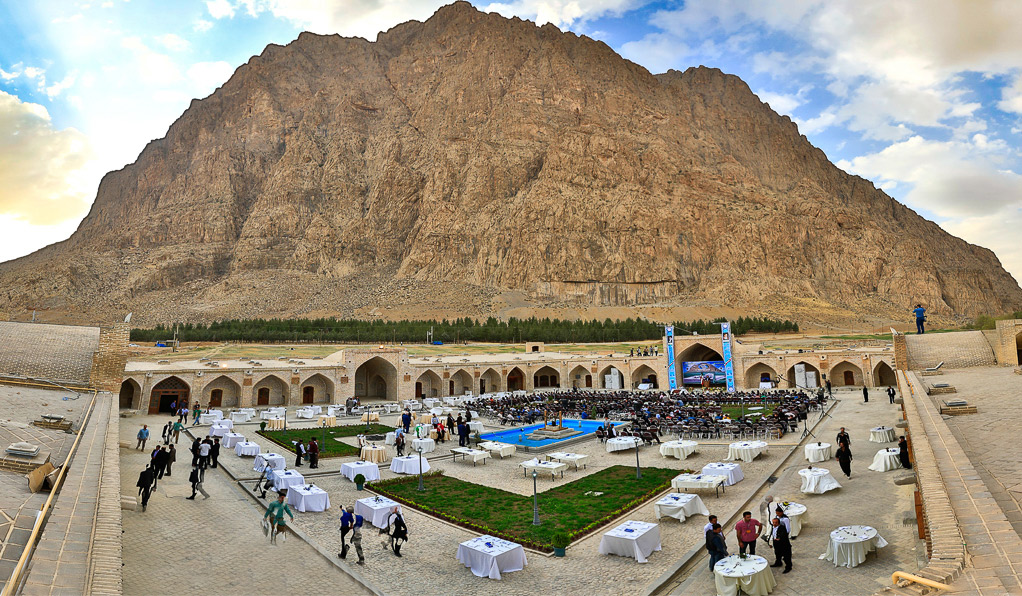
BISTOON LALEH HOTEL – KERMANSHAH
Located next to the Bistoon Inscription, a set of carved figures and engravings telling the story of Darius the Great, this atmospheric hotel is a renovated caravanserai dating back to the early 17th century. The hotels comfortable rooms are set around a large central courtyard that affords delightful views of the rugged escarpment.
DAAD HOTEL – YAZD
Located in the heart of ancient Yazd, the Daad is a beautiful hotel featuring wind-catchers, curved ceilings, a grand central courtyard and a delightful view from the roof over the city. The rooms are decorated in classic Iranian style, with the hotel being recognised by UNESCO for its culture heritage conservation.
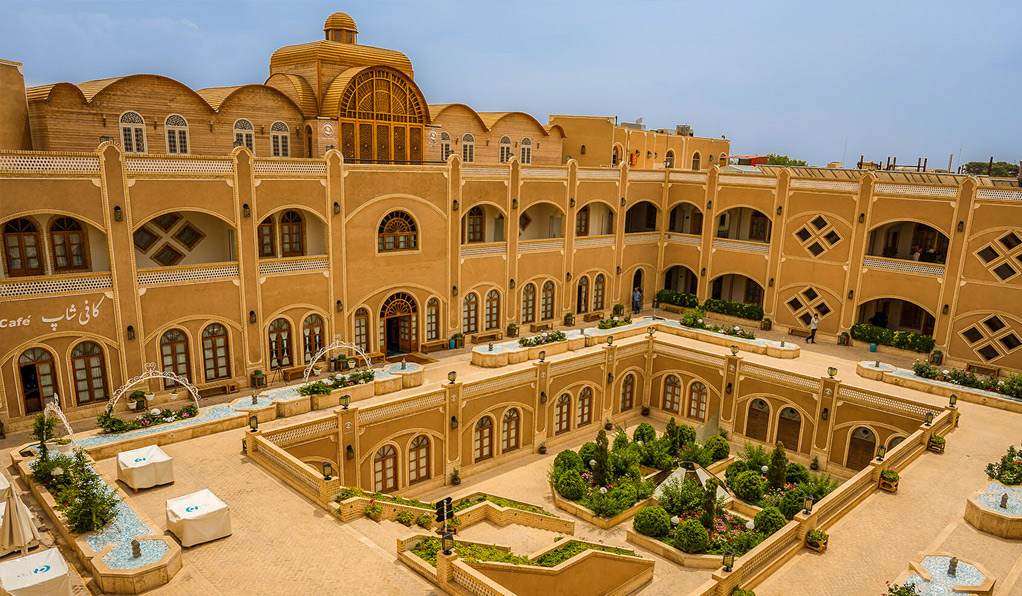
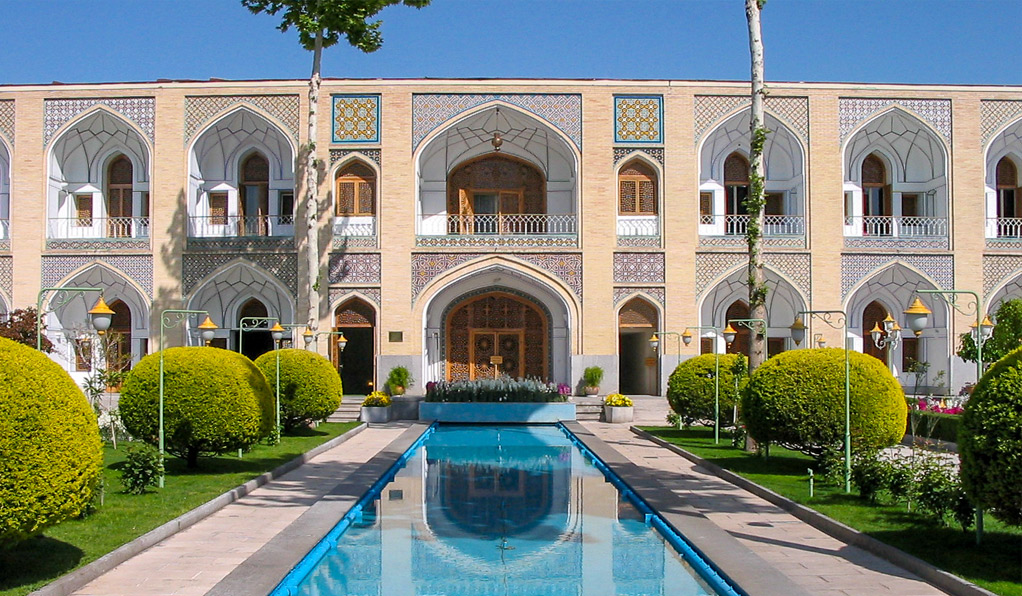
ABBASI HOTEL – ISFAHAN
The 300-year-old Abbasi hotel was once a stop for silk road traders and is today a tourist attraction in its own right. Often described as "the world's most beautiful hotel", the hotel is drenched warmly in an ancient past with beautiful mirror work, glittering chandeliers, and exquisite colourful oriental wall motifs.
INCLUSIONS
- Meals as per itinerary (25 breakfasts, 24 lunches, 25 dinners) including welcome and farewell dinners
- Private airport transfers (arrival and departure)
- Accommodation as stated on a twin-share basis
- Porterage at airports and hotels
- All land transport by private air-conditioned vehicle and train
- Services of an Arcadia Expedition Leader and English-speaking local guide throughout
- Sightseeing as specified including entrance fees to sites mentioned in itinerary
- Reusable responsible travel water bottle with daily drinking water provided
- Gratuities/tipping for local guides, drivers, hotel staff and restaurants for included meals
- All taxes
EXCLUSIONS
- Return international flights
- Passport and visa charges
- Items of a purely personal nature (i.e. telephone calls, laundry etc)
- Excess luggage
- Lunch and dinners not specifically mentioned as included in itinerary
- Travel insurance
THE ARCADIA DIFFERENCE
The art of storytelling
Each of our meticulously researched expeditions is created around a theme. Our aim is to tell a story that has never been told in this type of travel format before. Whilst our expeditions include the well-known sites of a destination, and plenty of hidden gems, the story is woven throughout the journey, so that we explore a country’s history, culture and people from a different perspective.
Fully escorted with an expert trip leader and local guide
Each expedition has a leadership team of two: an expert on the trip theme to narrate the story of the journey (an academic, author or researcher) plus a local guide who shares their local knowledge, culture and experience to reveal the spirit of their country. They are the ultimate travel companions and are trained to make every part of the trip safe and seamless.
Small groups
Our expeditions have a maximum group size of either 12 or 16 travellers. Small groups of like-minded travellers allow low-impact, intimate access to our destinations and more time with our experts. Each member of our group will bean integral part of the expedition, with our small group size allowing us to learn more about our traveller’s interests and incorporating them into the experience.
Exclusive access
Each itinerary has unique, one-off experiences that are exclusive to Arcadia Expeditions. Clients will have uncommon access to locations, people, archaeological digs, museums and other sites and experiences that other travellers only dream of.
Luxury accommodation
When travelling in major centres, we stay in 5-star properties chosen for their character, comfort and central location. More often than not, they have their own story to tell. In more remote areas, we choose the best boutique property available or set up luxury tented camps to explore further afield.
Responsible travel
Responsible Travel philosophies are built into each of our expeditions. We help sustain and preserve communities, cultures and traditions on our travels and offer our travellers plenty of ways to leave lighter footprints and make a positive impact.
Balanced itineraries
Our expeditions are planned to interact with local people and connect with the culture of our destinations. Special emphasis is placed on food. We believe that some of the best travel experiences are those that are unplanned and spontaneous, which is why each of our itineraries has a balance of planned activities and free time for you to explore on your own.
Choose your own adventure
On certain days in each expedition, our travellers are given the freedom to choose included activities that cater to different interests. Our activities are not your standard mass-tourism offerings, but rather carefully curated experiences that give a taste of local life and culture.
